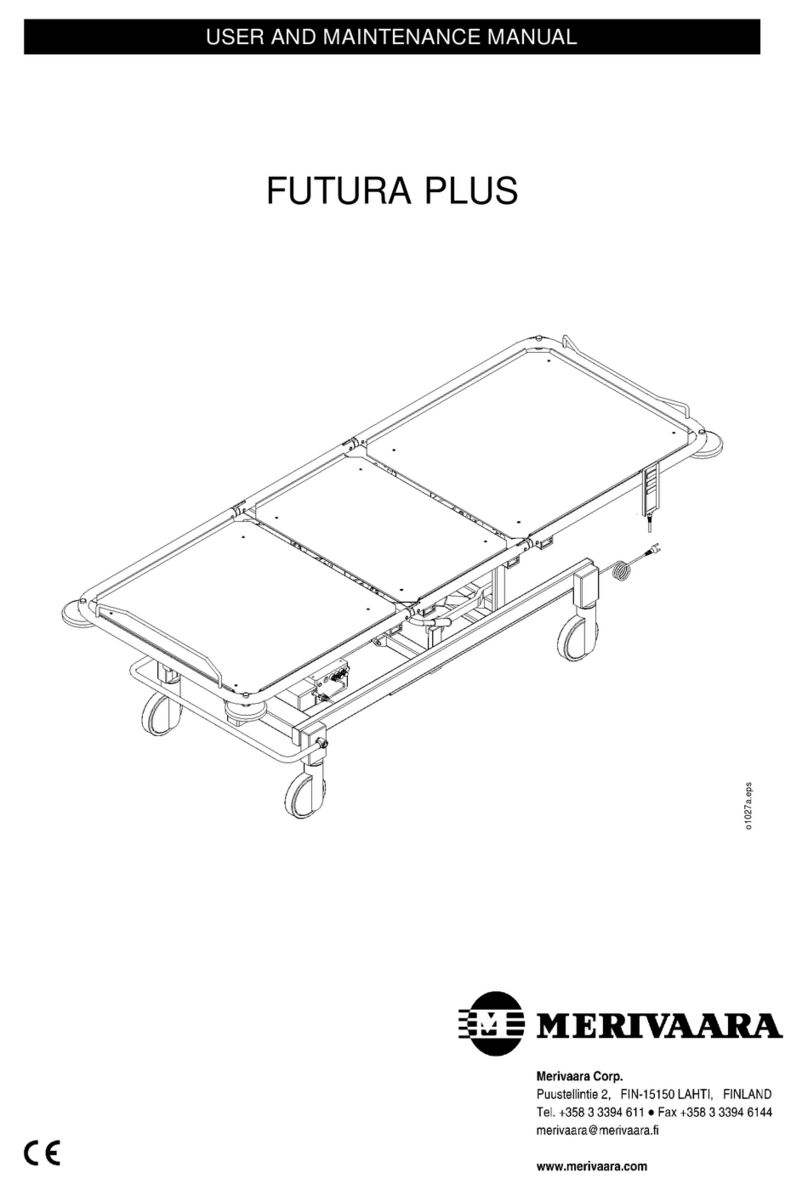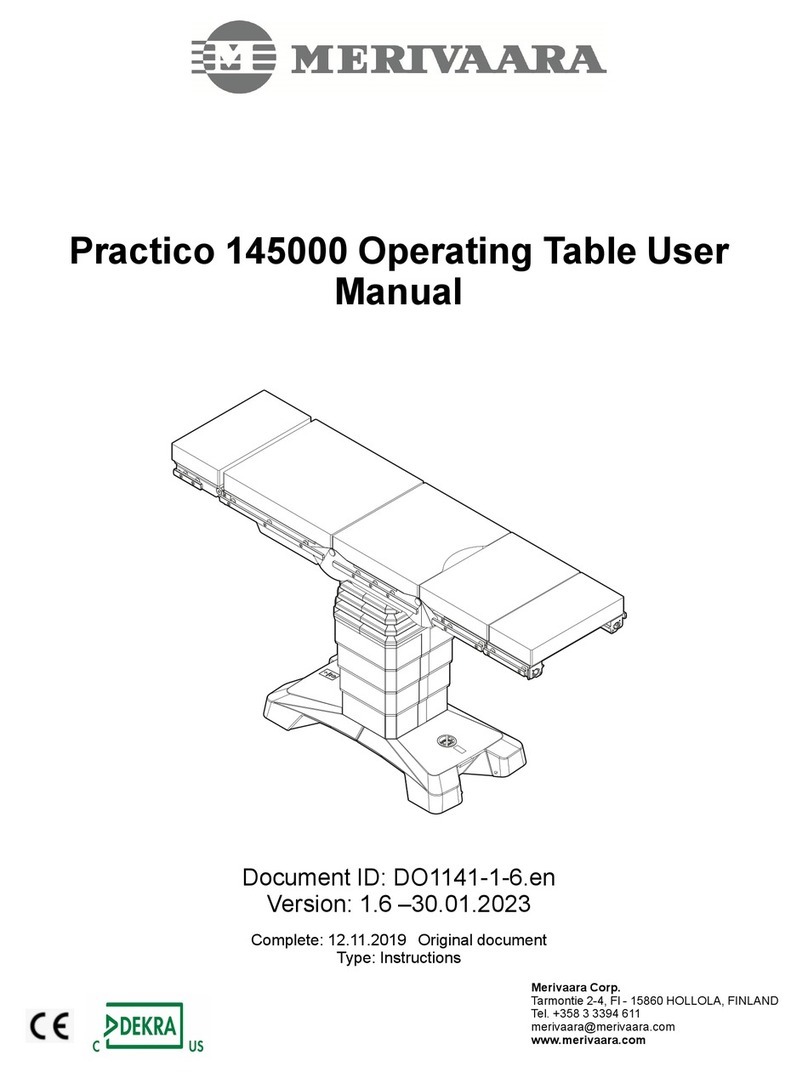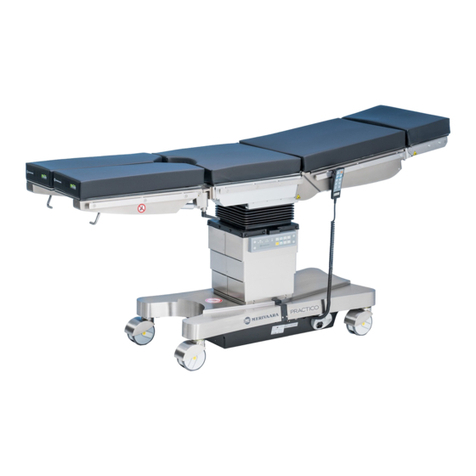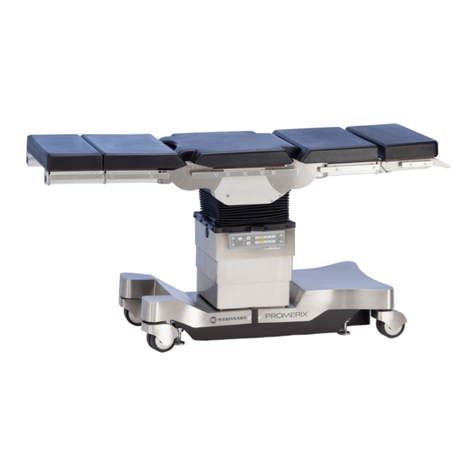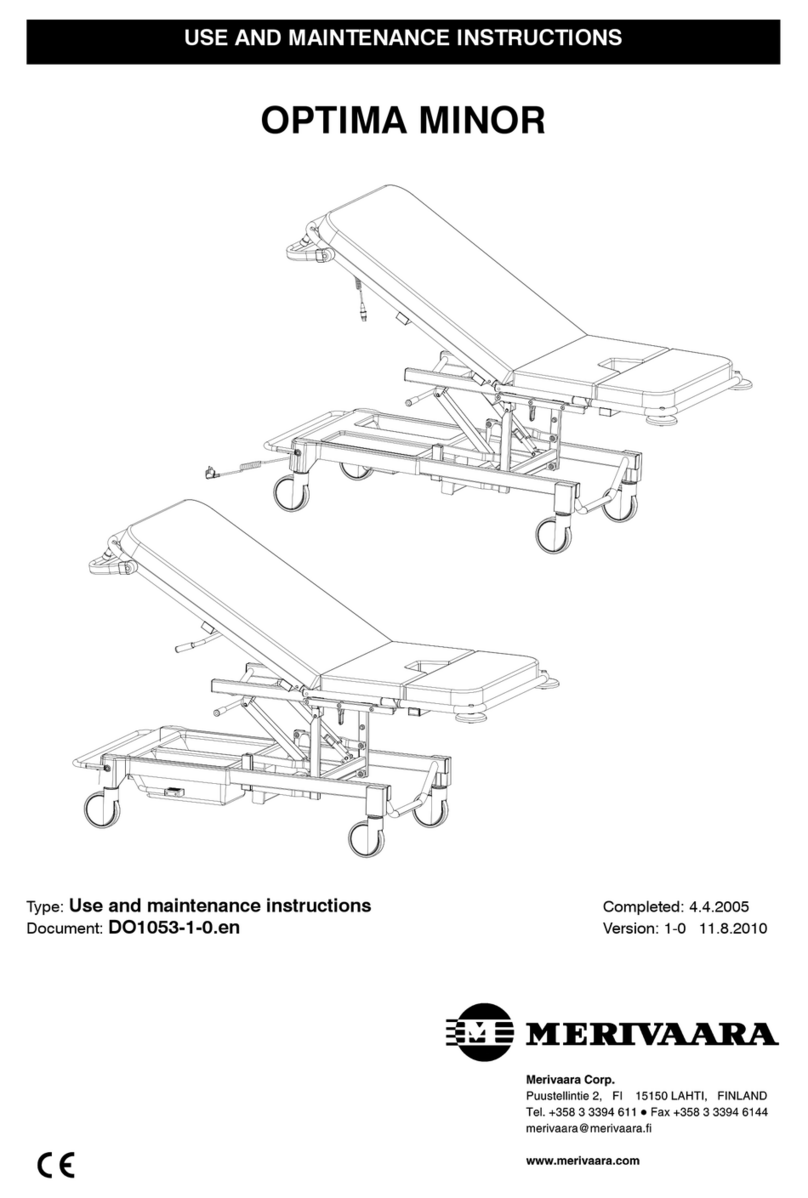Merivaara OP 1700 User manual

MAINTENANCE MANUAL
OPERATING TABLE OP 1700
o1025a.eps

2
1GENERAL 4
2 TECHNICAL SPECIFICATIONS 5
2.1 Identification plate 5
2.2 Properties and materials 5
2.2.1 Conditions 5
2.2.2 Adjustments 5
2.2.3 Dimensions 6
2.2.4 Surface materials 6
3PRODUCTUSE 7
3.1 Special instructions 7
3.1.1 Warnings 7
3.1.2 Important 7
3.2 Main components 8
4CLEANING 9
4.1 Daily cleaning and disinfecting 9
4.1.1 Disinfecting 9
4.1.2 Drying 9
5 MAINTENANCE AND REPAIR 10
5.1 Maintenance procedures 10
5.1.1 Daily maintenance 10
5.1.2 Monthly maintenance 10
5.1.3 Annual maintenance 10
5.2 Troubleshooting 11
5.3 Removal of protective casings 12
5.3.1 Removal of base casing 12
5.3.2 Removal of column casings 12
Compiled by: Mika Similä Type: Maintenance manual Complete: 29.5.2001
Approved by: Arto Koski-Laulaja Document: DO1025.en Version: 01 - 10.12.2001

3
5.4 Brake and column clearance 13
5.4.1 Removal of brake pins and plugs 13
5.4.1.1 Brake adjustment 13
5.4.2 Castors 13
5.4.3 Adjustment of column clearance 13
5.5 Hydraulics 14
5.5.1 Hydraulic pressures 14
5.5.1.1 Pressure release 14
5.5.1.2 Checking pressure 14
5.5.1.3 Pressure adjustment 14
5.5.2 Gauging oil level 14
5.5.3 Removal of hydraulic pump 14
5.5.3.1 De-airing hydraulic pump 15
5.5.4 Removal of pressure accumulators 15
5.6 Cylinder replacement 15
5.6.1 Removal of height adjuster cylinder 15
5.6.2 Removal of side tilt cylinder from column 16
5.6.3 Removal of Trendelenburg cylinder from column 16
5.6.4 Replacement of back section gas spring 17
5.7 Selector 17
5.8 Replacement of gas springs 18
5.8.1 Replacement of leg section gas spring 18
5.8.1.1 Removal of gas spring from protective sleeve 18
5.8.2 Replacement of headrest gas spring 18
5.9 Connection of hydraulics 19
6RECYCLING 20
6.1 Metals and plastics 20
6.1.1 Gas springs 20
6.1.2 Hydraulics 20

4
Dear operating table owner. The safe and fault-free use and maintenance of the equipment requires careful
adherence to these instructions. When mounting accessories to the equipment, the instructions provided
with them must be followed closely. Always keep the instructions for accessories together with this manual.
Warnings and observations in this instruction manual are indicated as follows:
WARNING! Please observe in order to ensure patient safety.
NOTE! Please observe in order to avoid causing damage to the equipment or its parts.
• Warnings and Notes are given on page 7, 15, 16 and 20.
The OP 1700 operating table complies with the IEC 601-2-46 and SFS-EN 60601-1 standards. The table
complies with directive 93/42/EEC (MDD) product class I and bears a CE marking based on this
classification.
Intended use
The Merivaara OP 1700 operating table is intended for general surgery applications as well as most
specialised areas of surgery.
1. GENERAL
Your Specialist for integrated Medical
Furniture and Equipment Systems.
Merivaara products form an integrated furnishing system
for clinical, hospital and nursing home enviroments. The
comprehensive range of Merivaara products includes
high-quality tools and equipment needed in a variety of
medical procedures.
Merivaara products feature flexible design, turn easily into
ideal working positions and offer high patient comfort.
Daily nursing procedures are readily accommodated by
the safe and easy operation of all Merivaara products.
The comprehensive selection of (available) accessories
make our products ideal for several speciality proce-
dures.
You can get more information on Merivaara products,
from our Sales Office. For matters related to equipment
servicing, please contact the Merivaara After Sales
Department.

5
2.1 Identification plate
The identification plate is located underneath the seat.
2.2 Properties and materials
2.2.1 Conditions
Ambient temperature +10 ... +40 °C
Ambient pressure 700 ... 1060 mbar
Relative humidity 30% ... 75 %
Transport temperature - 10 ... +40 °C
Storage temperature +10 ... +40 °C
Safe working load
(incl. patient, mattress and accessories) 135 kg
2.2.2 Adjustments
Side tilt ±15°
Back section - 15° ... +70°
Leg section - 90° ... +0°
Trendelenburg and anti-Trendelenburg - 25° ... +25°
Headrest - 40° ... +30°
2. TECHNICAL SPECIFICATIONS
INSTRUMENTARIUM CORP.
FI-15150 LAHTI
MADE IN FINLAND
MODEL 12345/6789
SERIAL NO 1234-5678910
=135 kg
Model number
Serial number
Read instructions
Safe working load
(incl. patient, mattress and accessories)
o1017b.eps

6
2.2.3 Dimensions
Table 1. Dimensions
2.2.4 Surface materials
Table 2. Surface materials used on operating table.
OP 1700
Operating table top 4 - piece
Operating table weight 145 kg
Length (A) 1950 mm
Width (B) 620 mm
Height (C) 730 - 1040 mm
Mattress width (D) 500 mm
Mattress base width (E) 555 mm
Castors 75 mm
Surface materials OP 1700
Epoxy-powder coat, frame parts X
Stainless steel casing, columns, side rails X
Chroming, handles, adjuster levers, pedal tubing X
ABS (acrylonitrile/butadiene/styrene) protective casing X
PU integral, mattresses X
Rubber 61 bellows X
Anodised aluminium, selector valve X
LDPE (polyethylene), selector valve cover plug X
o1023b.eps
A
B
C
E
D

7
3.1 Special instructions
In order to guarantee optimal surgical safety all users of the operating table must thoroughly acquaint
themselves with the operating table operating instructions prior to using the table. Train the entire
surgery staff in the correct use of the OP 1700 operating table and all warnings and notes
related to it.
3.1.1 Warnings
When adjusting the table, ensure that the patient’s fingers, hands or other parts of the body are not caught
between the moving parts of the back or leg section or the seat.
Adhere to the manufacturer’s instructions when using diathermic or defibrillating equipment.
3.1.2 Important
The anti-static properties of the operating table require the use of only Merivaara brand mattress sets and
anti-static flooring.
Note ! Keep in mind that if the operating table surface is not raised high enough when the leg section is
adjusted to its lowest position, it may strike the table base casing and cause damage to the
table.
3. PRODUCT USE

8
3.2 Main components
o1025b.eps
Back section
Head section Leg section
gas spring, 2 pcs
hydraulic cylinder, 2 pcs
gas spring
Side tilt
hydraulic cylinder
Trendelenburg
hydraulic cylinder
Height adjustment
hydraulic cylinder
height adjustment
hydraulic pump
Hydraulic pedal
Brake pedal
Selector
Head section
handle
Pressure accumulator

9
4.1 Daily cleaning and disinfecting
The OP 1700 operating table must be cleaned after completion of and prior to every
surgery. Wipe down the mattresses and operating table top with a mild alkaline detergent
(pH 7-8).
4.1.1 Disinfecting
Wipe using, for example, a 3% chloramine-based disinfectant (Klorilli) or similar cleaning agent.
Normal excretion stains are removed and disinfected with a 10% chloramine-based disinfectant.
Isolation patient excretion stains are cleaned and table surface is disinfected with a 25% chloramine-based
disinfectant.
4.1.2 Drying
Dry thoroughly by wiping down immediately after cleaning or disinfecting.
4. CLEANING

10
5.1 Maintenance procedures
We recommend the following advance check-up and maintenance procedures to ensure continued
maintenance and trouble-free operation of the OP 1700 operating table.
5.1.1 Daily maintenance
• During normal cleaning of the table, make a general visual inspection
to ensure that it is in proper working order.
• The OP 1700 operating table must be cleaned after each surgical procedure
(see section 4.1 on page 9).
5.1.2 Monthly maintenance
• Clean and lubricate all table joints lightly with machine oil.
• Check all table functions by fully extending and retracting them.
5.1.3 Annual maintenance
• Perform all the same inspections as in monthly maintenance.
• Check and adjust column clearance, if required.
• Check cylinders, hydraulic lines and their connections.
• Check pressure accumulator pressure.
• Check condition of castors and brakes.
5. MAINTENANCE AND REPAIR

11
5.2 Troubleshooting
In the event of a malfunction, determine the following:
• Does the malfunction occur in all movements or only one movement?
• Does the malfunction occur in both up and down movements or only in one direction?
• Does the table move into a certain position(s) by itself?
List of components whose breakage causes malfunction in all table hydraulic functions:
•Pump
• Pressure release valve
If the malfunction is restricted to only one function, the problem is probably:
• in the lines
• in the selector valve
• in the cylinder
Problem Cause
Table top will not remain at the adjusted height • Leak in hydraulic cylinders, lines or
connectors
• Faulty valve
•Dirtinhydraulicsystem
Operating table top will not rise • Oil level low
• Air in the hydraulic system
• Faulty pump
• Pressure release valve dirty or faulty
Mattress base will not lower properly • Faulty pump
• Air in the hydraulic system
• Pressure in pressure accumulator too low
Operating table pulls to one side when being
pushed
• Worn or dirty castor
Headrest or leg section angle adjustment does not
stay in place or does not work at all.
• The gas spring is damaged
• Gas spring is installed incorrectly
• Release cable is loose or tight
Table top flexing. • Air in the hydraulic system
• Oil level too low

12
5.3 Removal of protective casings
5.3.1 Removal of base casing
• Loosen screws (1).
• Lift up the column’s telescopic casings (2) and hang them from the mattress base.
• Loosen the screws (3) and lift the casing (4) from its corner.
• Turn the casing into the suitable position and hang from the mattress base or support on the base.
5.3.2 Removal of column casings
• Remove screw (1) and washer (2).
• Lift up the protective hood (3)
and remove screws (4) (4 pcs) from
the top of the casing.
• Remove the screws (5) (6 pcs) from
the upper casing and remove
the casing halves (6)
• First remove screws (7) (4 pcs) and
then screws (8) (4 pcs).
• Remove casing halves (9).
1
4
o1026i.eps
3
2
o1025c.eps
2
14
3
6
5
6
9
9
7
8

13
5.4 Brake and column clearance
5.4.1 Removal of brake pins and plugs
• Remove the retaining ring (1) and spring (2)
from both sides.
• Remove the retaining ring (3) and interlock pin (4).
• Pull out brake pins.
• Brake pin plugs (5) can be removed with,
for example, a flat head screwdriver.
5.4.1.1 Brake adjustment
Turn the adjuster screws (6) until there is no clearance in
brake pins and they move easily up and down.
5.4.2 Castors
Removal of front castor
• Remove screw (1) and take the
front castor (2) off.
Removal of rear castor
• Remove plug (3) and loosen screw (4).
• Remove rear castors (5) and washer (6).
5.4.3 Adjustment of column clearance
• First, raise the table at least 20 cm from its lowest
position.
• Remove column casing as shown in in section 5.3.2.
• Loosen retaining screws (1) (2 pcs) on both sides
of the column.
• Loosen with the locking nuts (2), one on each side
of the column.
• Adjust the column until it moves without clearance
using adjuster screws (3).
• Move the column up and down while checking the clearance.
• Lock the adjuster screws (3) with locking nuts (2) and ensure that
the adjuster screws do not move out of position while locking.
• Tighten retaining screws (1).
4
1
2
3
5
6
o1026f.eps
6
1
o1026g.eps
3
5
2
4
3
12
o1026h.eps

14
5.5 Hydraulics
5.5.1 Hydraulic pressures
Prior to removing hydraulic parts. Ensure that the mattress base and
column cylinders are in their lowest positions and the accumulator pressure has been released.
5.5.1.1 Pressure release
• Set the side tilt adjustment from the selector valve.
• Remove the pressure gauge connector cover (1) and connect the pressure gauge.
• Open the ball valve (2) and lift the pedal
until the gauge reads 0 bar.
5.5.1.2 Checking pressure
• Put the table top into its horizontal position.
• Remove the pressure gauge connector cover (1)
and connect the pressure gauge.
• The pressure in the accumulator should be 60 bar.
5.5.1.3 Pressure adjustment
• Move the selector into side tilt position and pump the table top into its outermost position.
• Remove the pressure gauge connector cover (1) and connect the pressure gauge.
• Open the ball valve (2) and pump the pedal until the gauge reads 63 bar.
• If required, the pressure can be reduced by lifting the pedal.
• Check the pressure as shown in in section 5.5.1.2.
5.5.2 Gauging oil level
• Open oil tank cap (1).
• Wipe off dipstick and screw back into place.
• Open and check oil level.
The oil level should come to the dipstick ring.
The oil recommended for use is Shell Tellus 32 or similar.
5.5.3 Removal of hydraulic pump
• Lift the protective casing to the side.
Casing removal
in section 5.3.1 on page 12.
• Remove the roll pin (1) and pedal (2).
• Disconnect connectors (3) and (4).
• Loosen screws (5) and (6).
• Remove pump (7).
o1025l.eps
1
2
Open
Closed
o1025m.eps
1
o1025d.eps
4
1 27
6
3
5

15
5.5.3.1 De-airing hydraulic pump
Air may enter the hydraulic system when tilting the table during maintenance.
Air in the system will cause the following problems:
• the mattress base will not rise when pumping or part of the pedal pump action is ‘empty’.
• When lowering, the table shakes or the movement is jerky.
The air is de-air from the system when the table is pumped into its upper position, and then pumped
an additional 10 - 20 times. Lower the table and check movements.
5.5.4 Removal of pressure accumulators
• Lift the protective casing to the side. Casing
removal in section 5.3.1 on page 12.
• Pressure release in section 5.5.1.1 on page 14.
• Disconnect hydraulic lines (1).
• Loosen screw (2).
• Open pressure tank (3).
5.6 Cylinder replacement
5.6.1 Removal of height adjuster cylinder
• Remove column casing as shown
in section 5.3.2.
• Disconnect the connector (1).
• Lay the operating table on its side.
• Loosen nut (2) and remove washer (3)
• Loosen screws (4) and pull cylinder (5) out
approximately 50 mm.
• Break the truss binding (6).
• Loosen screw (7) and remove protective
collar (8).
• Pull cylinder out until the line connector (9)
comes into view and open connector.
• Pull cylinder out.
NOTE! When pulling the cylinder out, ensure
that the blue line does not
kink, as this will damage it.
o1025n.eps
2
1 3
o1025g.eps
32
87
4
5
o1025e.eps
o1025h.eps
9
6
1
o1025f.eps

16
5.6.2 Removal of side tilt cylinder from column
• Remove column casing as shown
in section 5.3.2.
• Pressure release in section 5.5.1.1 on page 14.0
• Support the operating table so it will not fall over.
• Remove screws (1) and seat base plate (2).
• Remove screws (3) and guard plate (4).
• Disconnect hydraulic lines (5).
• Remove the retaining ring (6) and pin (7).
• Loosen retaining screws (8) and remove
screws (9) and axle (10).
• Loosen screw (11) and remove mounting
bracket (12).
• Remove the nut (13) and bushing (14) from
the lower end of the cylinder.
• Pull cylinder (15) down through its protective hood.
NOTE! When mounting the lower end of the cylinder,
remember to leave 0.5 mm clearance for the bushing.
5.6.3 Removal of Trendelenburg cylinder from column
• Remove column casing as shown
in section 5.3.2.
• Pressure release
in section 5.5.1.1 on page 14.
• Support the leg section of the mattress
base so that it will not fall.
• Disconnect hydraulic lines (1).
• Remove the retaining rings (2) and pin (3)
and bushings (4).
• Remove bushings (5) and pins (6).
• Pull cylinder (7) down through its
protective hood.
3
1
11
o1025i.eps
7
6
Support
2
4
810
9
12
14
15
13
5
1
o1025j.eps
Support
2
6
4
2
5
3
7

17
5.6.4 Replacement of back section gas spring
• Pressure release
in section 5.5.1.1 on page 14.
• Remove screws (1).
• Remove bushings (2).
• Turn out the accessory rail (3).
• Disconnect hydraulic lines (4).
• Remove retaining rings (5).
• Remove pins (6) and bushings (7).
• Remove cylinder (8).
5.7 Selector
• Pressure release in section 5.5.1.1 on page 14.
• Loosen retaining screw (1).
• Remove screw (2) and washers (3).
• Lift selector valve (4) out of mounting rod (5)
and loosen screw (6).
• Pull the selector valve out of its housing (7).
• Disconnect hydraulic lines (8).
When re-installing, turn the bushing (9) so that
its spring lock pin (10) is in line with
the hole on the selector valve.
5
6
5
6
2
1
4
o1025k.eps
7
8
2
1
3
o1025o.eps
Height
Side tilt
Back section
Trendelenburg
1
4
2
P
3
Pressure
2
3
6
9
1
4
7
5
10
8

18
5.8 Replacement of gas springs
5.8.1 Replacement of leg section gas spring
Remove leg section from the operating table
and turn it upside down.
• Remove screws (1).
• Remove bushings (2).
• Turn out the accessory rail (3).
• Remove retaining rings (4).
• Remove pins (5).
• Remove gas spring (6).
5.8.1.1 Removal of gas spring from protective sleeve
• Remove gas spring ram mount (1).
• Pull gas spring (2) out of protective sleeve (3).
• Unscrew mounting bracket (4). Count the rotations
for remounting.
5.8.2 Replacement of headrest gas spring
Remove leg section from the operating table and turn it
upside down.
• Remove retaining rings (1).
• Remove pins (2).
• Remove release lever (3) and bushings (4).
• Unscrew mounting bracket (5). Count the rotations
for remounting.
3
6
5
o1026e.eps
2
1
4
42
5
o1017m.eps
2
3
14
1
2
2
3
4
5
o1026c.eps

19
5.9 Connection of hydraulics
Pressure
gauge
Back section cylinder
Trendelenburg
cylinder
Side tilt cylinder
Height adjustm
e
Pump
Ball valve
Pressure accumulators
Selector valve
left side
Back section cylinder
right side
cylinder
connector
o1025p.eps

20
6.1 Metals and plastics
When disposing of an operating table or replacing any of its parts, check the recyclability of each item. A
majority of the metal used on the operating table is steel. The operating table also contains a number of zinc
castings and brass bushings. When recycling plastic parts, determine the material type. The table on page 6
lists part materials, which will provide assistance in determining the correct recycling procedure. If a part
material is missing from the table, contact your sales representative. For more information on recycling,
contact your local waste management facility or visit related sites on the Internet.
Below are recycling symbols, which are marked on parts made of plastic. Products marked with these
symbols can be used as energy waste.
6.1.1 Gas springs
Gas springs can be disposed of as metal waste after all nitrogen gas and oil has been removed from them.
WARNING! Releasing nitrogen gas is strictly prohibited, without following the proper instructions.
Your sales representative will provide the necessary instructions for the correct disposal
of gas springs.
6.1.2 Hydraulics
Hydraulic cylinders can be disposed of as metal waste after all oil has been removed from them.
6. RECYCLING
Table of contents
Other Merivaara Medical Equipment manuals
Popular Medical Equipment manuals by other brands

Getinge
Getinge Arjohuntleigh Nimbus 3 Professional Instructions for use

Mettler Electronics
Mettler Electronics Sonicator 730 Maintenance manual

Pressalit Care
Pressalit Care R1100 Mounting instruction

Denas MS
Denas MS DENAS-T operating manual

bort medical
bort medical ActiveColor quick guide

AccuVein
AccuVein AV400 user manual
